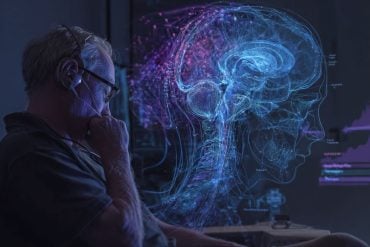Summary: Study suggests quantum processes are part of cognitive and conscious brain functions.
Source: TCD
Scientists from Trinity College Dublin believe our brains could use quantum computation after adapting an idea developed to prove the existence of quantum gravity to explore the human brain and its workings.
The brain functions measured were also correlated to short-term memory performance and conscious awareness, suggesting quantum processes are also part of cognitive and conscious brain functions.
If the team’s results can be confirmed – likely requiring advanced multidisciplinary approaches –they would enhance our general understanding of how the brain works and potentially how it can be maintained or even healed. They may also help find innovative technologies and build even more advanced quantum computers.
Dr Christian Kerskens, lead physicist at the Trinity College Institute of Neuroscience (TCIN), is the co-author of the research article that has just been published in the Journal of Physics Communications.
He said:
“We adapted an idea, developed for experiments to prove the existence of quantum gravity, whereby you take known quantum systems, which interact with an unknown system. If the known systems entangle, then the unknown must be a quantum system, too. It circumvents the difficulties to find measuring devices for something we know nothing about.
“For our experiments we used proton spins of ‘brain water’ as the known system. ‘Brain water’ builds up naturally as fluid in our brains and the proton spins can be measured using MRI (Magnetic Resonance Imaging). Then, by using a specific MRI design to seek entangled spins, we found MRI signals that resemble heartbeat evoked potentials, a form of EEG signals. EEGs measure electrical brain currents, which some people may recognise from personal experience or simply from watching hospital dramas on TV.”
Electrophysiological potentials like the heartbeat evoked potentials are normally not detectable with MRI and the scientists believe they could only observe them because the nuclear proton spins in the brain were entangled.
Dr Kerskens added:
“If entanglement is the only possible explanation here then that would mean that brain processes must have interacted with the nuclear spins, mediating the entanglement between the nuclear spins. As a result, we can deduce that those brain functions must be quantum.

“Because these brain functions were also correlated to short-term memory performance and conscious awareness, it is likely that those quantum processes are an important part of our cognitive and conscious brain functions.
“Quantum brain processes could explain why we can still outperform supercomputers when it comes to unforeseen circumstances, decision making, or learning something new. Our experiments performed only 50 metres away from the lecture theatre, where Schrödinger presented his famous thoughts about life, may shed light on the mysteries of biology, and on consciousness which scientifically is even harder to grasp.”
Funding: This research was supported by Science Foundation Ireland and TCIN.
About this neuroscience research news
Author: Thomas Deane
Source: TCD
Contact: Thomas Deane – TCD
Image: The image is in the public domain
Original Research: Open access.
“Experimental indications of non-classical brain functions” by Christian Kerskens et al. Journal of Physics Communication
Abstract
Experimental indications of non-classical brain functions
Recent proposals in quantum gravity have suggested that unknown systems can mediate entanglement between two known quantum systems, if the mediator itself is non-classical. This approach may be applicable to the brain, where speculations about quantum operations in consciousness and cognition have a long history.
Proton spins of bulk water, which most likely interfere with any brain function, can act as the known quantum systems. If an unknown mediator exists, then NMR methods based on multiple quantum coherence (MQC) can act as an entanglement witness.
However, there are doubts that today’s NMR signals can contain quantum correlations in general, and specifically in the brain environment.
Here, we used a witness protocol based on zero quantum coherence (ZQC) where we minimized the classical signals to circumvent the NMR detection limits for quantum correlation.
For short repetitive periods, we found evoked signals in most parts of the brain, whereby the temporal appearance resembled heartbeat-evoked potentials (HEPs). We found that those signals had no correlates with any classical NMR contrast. Similar to HEPs, the evoked signal depended on conscious awareness.
Consciousness-related or electrophysiological signals are unknown in NMR. Remarkably, these signals only appeared if the local properties of the magnetization were reduced.
Our findings suggest that we may have witnessed entanglement mediated by consciousness-related brain functions.
Those brain functions must then operate non-classically, which would mean that consciousness is non-classical.







